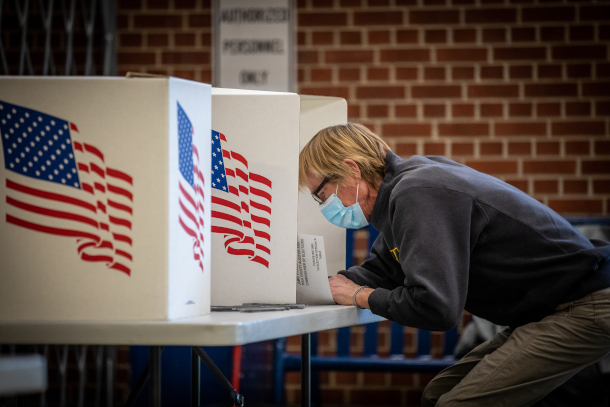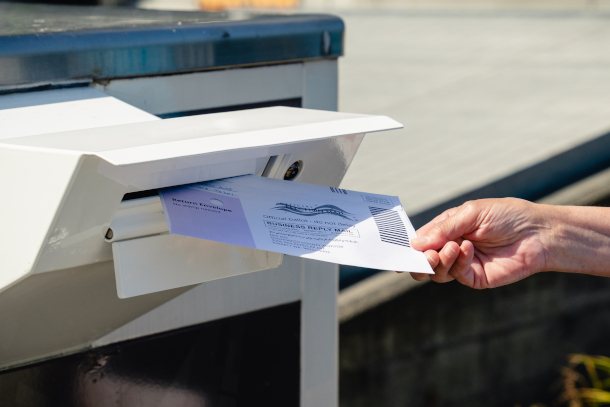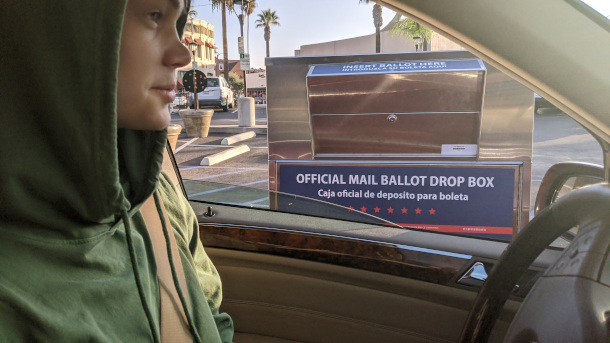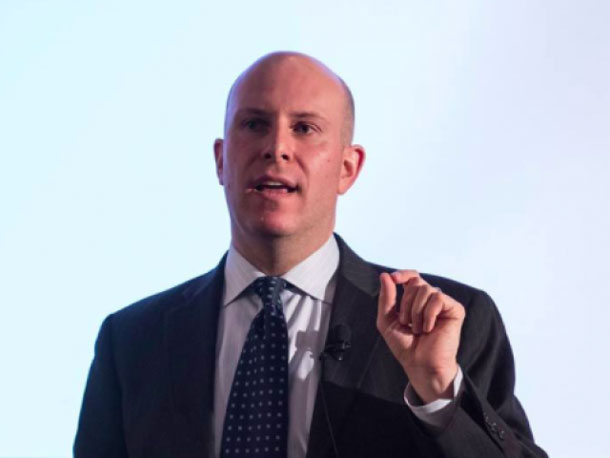Green Voters and the 2022 Midterms
Air Date: Week of September 9, 2022

The Environmental Voter Project identified 33% of environment-first registered voters who did not plan to vote in the 2022 midterm elections. (Photo: Phil Roeder, Flickr, CC BY 2.0)
Polls of environment-first registered voters showed that in July, as many as a third were planning to sit out the 2022 midterm elections, with most citing frustration with the lack of Congressional action on climate. Now the passage of the landmark climate legislation in the Inflation Reduction Act may be stirring up some voter turnout among climate conscious voters. Host Steve Curwood is joined by Nathaniel Stinnett, founder and executive director of the Environmental Voter Project, to discuss.
Transcript
CURWOOD: No doubt many voters for the upcoming mid-term elections are energized by the recent US Supreme Court decision permitting states to outlaw abortion, but climate- concerned voters could also make a small but still significant difference for who goes to the next Congress. Some polls suggest if the elections were held today Senate Democrats, now evenly split with the Republicans, may well increase their numbers, but the House could go either way. Those present slim margins squeezed through the passage of the Inflation Reduction Act earlier this year which is the first major US legislation to address the climate crisis. And to see if enough climate concerned voters will turn out to help keep climate action momentum going in the next Congress, we turn now to Nathaniel Stinnett founder and executive director of the Environmental Voter Project. Welcome back to Living on Earth, Nathaniel!
STINNETT: Thank you so much, Steve. It's so great to be back.
CURWOOD: Great to have you. Now talk to me about the data you have that shows that in July, roughly a third of environment first voters were uninterested in voting in the midterm elections. If you had to speculate, why do you think that was the case?
STINNETT: That's right, Steve. So in July, before news of the inflation Reduction Act came out, we polled 3,300 registered voters in four battleground states. So Arizona, Georgia, Nevada, and Pennsylvania. And we found a whole bunch of people, roughly about five or six percent of voters who listed climate as their top priority when choosing a candidate, but a whole third of them, so 33% of those climate-first voters, said they weren't motivated to vote in the upcoming midterms. And you ask why. And we actually have some pretty good data in the poll that tells us why they were really disappointed that Democrats in Congress weren't doing enough to address the climate crisis. And when I say they, not only were democratic climate first voters disappointed in congressional Democrats, but even 43% of independents said that they wanted Democrats in Congress to do more. So it's pretty clear: climate-first voters were disengaged, because Democrats in Congress weren't doing enough.
CURWOOD: So, with the passage of the inflation Reduction Act, which has what, some $370 billion worth of climate action baked into it, what do you think we'll see with environmental voter turnout now, in the upcoming midterms?
STINNETT: I think that there's very little doubt that turnout and enthusiasm will go up, it will go up pretty significantly. But let's keep in mind the denominator of the fraction too. I don't want to oversell this and make it seem like climate first voters make up, you know, a majority of the electorate. They don't, they don't, we're talking about, depending on the state five, six, seven percent of registered voters. So we in the climate movement, don't have nearly as much power as we need to have. And as we would like to have. But of those people who, whenever they vote, their top priority is climate, it seems pretty clear that they are now much more engaged and much more excited about voting than they were a month or two months ago. And we're starting to see that in some of the special elections. So the special elections recently in Alaska, but also in Kansas, and Nebraska, and Minnesota, and even some of the special congressional elections in New York. We see that young people, and to a lesser extent, people of color, and those are two demographic groups that make up the heart of the environmental movement, those two groups are really turning out in much higher numbers than we would otherwise expect.

The Inflation Reduction Act of 2022 was passed in the U.S. House of Representatives on August 12. All Democratic representatives voted yes to pass, while no Republican representatives did. (Screenshot: C-SPAN)
CURWOOD: And Nathaniel, say just a little bit more about who the environmental voters are.
STINNETT: So when we look at broad demographic groups, people who care deeply about climate and the environment, so these are people who are listing it as a top priority of theirs, they're much more likely to be women than men, they are much more likely to be young than old, particularly 18 to 34, they are much more likely to be Hispanic, or Asian American than white. Black voters are about about even though, they're not disproportionately more likely to care deeply about climate, but certainly Hispanic and Asian American voters are. And these climate first voters are much more likely to be lower income than upper income or middle income. So I just painted with four really broad demographic brushes. And obviously, there's a lot of interesting nuance when you dig further down. But by and large, we consistently see those four demographic trends.
CURWOOD: So you're talking, of course about registered voters, but this category can break down into likely and unlikely voters, which makes me curious how the unlikely voters stack up against the likely voters when it comes to the climate and environment.
STINNETT: Yeah, so I'm glad you brought that up, Steve, because it's so important. First, for your listeners to understand that, of course, who they vote for is secret. But whether they vote or not, that's public record. It's public record what elections you vote in, what elections you don't vote in. And if you're a politician who's trying to win the election, you better believe you're gonna run and look at those public records to figure out who has a history, who has a tendency of voting in this campaign that you're trying to win. And when you look at that, when you look at people's voting histories and break them down into people who are likely to vote in the upcoming midterms, and people who are unlikely to vote, the climate first registered voters are much more prevalent in that low propensity group, they're much more likely to be unlikely voters. And just to give you some examples, in this recent round of battleground state polling that we did, in Nevada, and Pennsylvania, two extremely important states this cycle, unlikely voters were twice as likely to list climate as their top priority, as likely voters were. And that means that turnout, voter turnout is going to be enormously important to the environmental movement this fall, not just in those two states, but in a lot of states.
Did you miss yesterday's Special Briefing on New York, the Midterms, and Environmental Voters?
— Environmental Voter Project (@Enviro_Voter) August 16, 2022
Don't worry, we've got you covered!https://t.co/nsXwmNK7Tw #ActOnClimate #ClimateCrisis #ClimateEmergency #ClimateActionNow #ClimateAction
CURWOOD: So why do you think so many climate environment first register voters are are so unlikely to vote?
STINNETT: You ask a million dollar question, Steve. And it's hard to answer because when you ask people why they aren't doing something, usually they give you the socially acceptable answer, they usually tell you what they think you want to hear. The honest answer is we don't know for sure, but we have a few hints of what's going on. The first is, as I mentioned before, the demographic trends that we see among these climate first voters, so they're younger, they're more likely to be people of color, and the more likely to be lower income. Well, what are those three groups have in common, they're all less likely to vote than the average voter. And a lot of that has to do with voter suppression. If anybody anywhere is trying to make it harder for someone to vote, chances are, they're targeting young people, people of color, or poor people. And that really hurts the political strength of the environmental movement every time there's an election. But the second thing that we think is going on, is for over a generation, the environmental movement has been strangely, apolitical. And I know that sounds pretty controversial. So let me explain what I mean by this. Chances are, when you grew up, you thought of environmental activism as picking up your litter, or changing what you eat, or changing how you get to work, or changing the electricity you consume, or something that had to do with your personal behavior. And you would never, ever hear someone who cares about gun rights or reproductive rights talk in such a strangely apolitical way. And this is not by accident. I mean, for decades, the fossil fuel industry has run very sophisticated PR campaigns, essentially trying to tell all of us "Don't pay attention to that coal fired power plant back there. It's all your fault, Steve, for having a plastic water bottle in your hand." Right? Like they're trying to blame us for these large systemic crises. And in many ways, we fallen for it, and we've become apolitical, and we blamed ourselves, rather than these big systemic actors. It not only keeps them from organizing around particular candidates and particular campaigns, it keeps them from even thinking about environmental or climate concerns as in the political realm. We've got a lot of sort of institutional memory to cut through. We have to try to convince people that actually politics is where the most important climate and environmental victories can be won and lost.

In two battleground states, Nevada and Pennsylvania, the Environmental Voter Project found that unlikely voters were twice as likely to list climate as their top priority, as likely voters were. (Photo: cyclotourist, Flickr, CC BY-NC 2.0)
CURWOOD: So given this $370 billion commitment to climate action under the Inflation Reduction Act, to what extent are environment and climate first voters are aware of the need to keep certain people in Congress in order to consolidate those gains. In other words, some would say that 370 billion is really just kind of a downpayment, that unless it's sustained with further action, that won't really amount to all that much.
STINNETT: Yeah. So I think you are objectively right, Steve, that a lot of people, I think, rightly view it as only a downpayment. And I also think you're right in asking, well, how aware of that are people who care deeply about climate and the environment. And there's very little data on that, but the little data that there is shows, they're not that aware of it. In fact, they're not even that aware of the Inflation Reduction Act beyond it simply being the first big climate win that we've had ever, to be honest. I mean, this is, without a doubt the largest piece of federal climate legislation in American history. And that is a really shallow understanding of what just happened and what needs to happen. But that is enough to turn non voters into voters. If you think of sort of the hierarchy of emotions that drive people to the polls. Usually, and none of us like to admit this, but it's true, if you get people angry, boy, does that make them good at voting. Then after getting them angry, getting them excited is almost as good. But the worst thing, the worst thing for voter turnout, is if they're disappointed. And I know from looking at a lot of this polling data, that there were a lot of environmentalists who spent the last year and a half disappointed, and that means they weren't going to show up. And now, a lot of them are really, really excited. Not because they have an in depth understanding of what the inflation Reduction Act means and what more we need. They don't. But because for the first time in a while, the wind is in their sails, and that means a lot and that gets people excited to vote.
CURWOOD: People like winners.
STINNETT: People like winners. Absolutely.
CURWOOD: There's not a huge number of voters who put the climate first, the environment first. But of course, when elections are tight, any segment that leans one way or the other can make a huge difference. So using that lens, what are some states to keep an eye on during these midterm elections?
As President Biden’s National Climate Advisor, I couldn't be more excited about the Inflation Reduction Act.
— President Biden (@POTUS) August 19, 2022
From securing a cleaner future for young people to advancing environmental justice for communities overburdened by pollution, this is a big step forward. –@ginamccarthy46 pic.twitter.com/c7OoWVDS3G
STINNETT: Because of their redistricting map getting thrown out at the last minute and having to be reworked, there are, depending on which prognosticator you look at, anywhere between eight and ten competitive US House seats in New York. And that is a huge number. I mean, I'd go so far as to say, control of the House of Representatives might be decided in New York State this fall. And so New York, especially up along the Hudson Valley, and out along Long Island, there are eight of those competitive seats just in those two areas are going to be really decisive, in part because New York usually isn't a battleground state. We've identified over 1.1 million super environmentalists in the state, who never vote in midterms. And that is a huge number in a state where there are only 13.4 million registered voters and only 6 million showed up last time there was a midterm. So this is a state that is going to be very important. And also environmental turnout is going to be very important.
CURWOOD: Now, of course, there's been a lot of talk surrounding voter turnout these days, from voters who prioritize abortion rights and voting rights, famously the constitutional question in Kansas pulled all kinds of people out to vote. Nathaniel, what overlap, if any, do you see between those voters and environment-focused voters?

Nathaniel Stinnett serves as Founder and Executive Director of the Environmental Voter Project. (Photo: Courtesy of the Environmental Voter Project)
STINNETT: We see a lot of alignment, in northeastern states, in particular, among people who list abortion rights as one of their top priorities and people who list climate change is one of their top priorities. So for instance, in Pennsylvania, if you list climate change as one of your top priorities, abortion rights is the next most likely issue that you will list as a top priority. Now, it isn't like in the southeast, or the southwest, there is no alignment. We just see that alignment as being the strongest in the middle Atlantic and northeastern states. So Maine, New Hampshire, Pennsylvania, to a lesser extent, Virginia, places like that. But in all parts of the country, there is a lot of alignment. And again, that gets back to some of the demographic correlations that we were talking about, Steve. If you care deeply about climate change and other environmental issues, you're more likely to be a woman than a man, you're more likely to be young than old, you're more likely to be a person of color than white, and you're more likely to be lower income than middle or higher income. And those are the four demographic groups that also care the most about abortion rights. And those are the four demographic groups that are most likely to be impacted by removing easy access to abortion. And so yes, we see a lot of overlap there. But it's at its strongest in the mid Atlantic and northeastern states.
CURWOOD: Well, we'll all be watching, I guess, come the night of that second Tuesday after the first Monday in November. Nathaniel Stinnett is the founder and executive director of the Environmental Voter Project. Thank you so much for taking the time with us today.
STINNETT: Thank you, Steve. It's always a pleasure to join you.
Links
Learn more about the Environmental Voter Project
Environmental Voter Project | “Battleground State Poll: new data on voters in AZ, GA, NV, and PA”
Living on Earth wants to hear from you!
Living on Earth
62 Calef Highway, Suite 212
Lee, NH 03861
Telephone: 617-287-4121
E-mail: comments@loe.org
Newsletter [Click here]
Donate to Living on Earth!
Living on Earth is an independent media program and relies entirely on contributions from listeners and institutions supporting public service. Please donate now to preserve an independent environmental voice.
NewsletterLiving on Earth offers a weekly delivery of the show's rundown to your mailbox. Sign up for our newsletter today!
 Sailors For The Sea: Be the change you want to sea.
Sailors For The Sea: Be the change you want to sea.
 The Grantham Foundation for the Protection of the Environment: Committed to protecting and improving the health of the global environment.
The Grantham Foundation for the Protection of the Environment: Committed to protecting and improving the health of the global environment.
 Contribute to Living on Earth and receive, as our gift to you, an archival print of one of Mark Seth Lender's extraordinary wildlife photographs. Follow the link to see Mark's current collection of photographs.
Contribute to Living on Earth and receive, as our gift to you, an archival print of one of Mark Seth Lender's extraordinary wildlife photographs. Follow the link to see Mark's current collection of photographs.
 Buy a signed copy of Mark Seth Lender's book Smeagull the Seagull & support Living on Earth
Buy a signed copy of Mark Seth Lender's book Smeagull the Seagull & support Living on Earth

